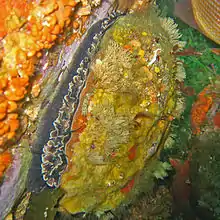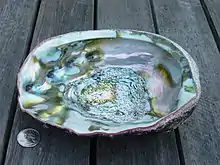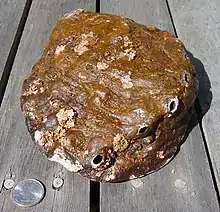Haliotis rufescens
Haliotis rufescens (red abalone) is a species of very large edible sea snail in the family Haliotidae, the abalones, ormers (British) or paua.[3] It is distributed from British Columbia, Canada, to Baja California, Mexico.[4][5] It is most common in the southern half of its range.[4]
| Haliotis rufescens Temporal range: | |
|---|---|
 | |
| Scientific classification | |
| Domain: | Eukaryota |
| Kingdom: | Animalia |
| Phylum: | Mollusca |
| Class: | Gastropoda |
| Subclass: | Vetigastropoda |
| Order: | Lepetellida |
| Superfamily: | Haliotoidea |
| Family: | Haliotidae |
| Genus: | Haliotis |
| Species: | H. rufescens |
| Binomial name | |
| Haliotis rufescens Swainson, 1822 | |
| Synonyms[3] | |
| |


Red abalone is the largest and most common abalone found in the northern part of the state of California.[6]
Habitat
Red abalone live in rocky areas with kelp. They feed on the kelp species that grow in their home range, including giant kelp (Macrocystis pyrifera), feather boa kelp (Egregia menziesii), and bull kelp (Nereocystis luetkeana). Juveniles eat coralline algae, bacteria, and diatoms.[7] They are found from the intertidal zone to water more than 180 m (590 ft) deep, but are most common between 6 and 40 m (20 and 131 ft).[4]
Shell description
The red abalone's shell length can reach a maximum of 31 cm (12 in), making it the largest species of abalone in the world.[8]
The shell is large, thick, dome-shaped, and usually covered with barnacles, vegetation, or other marine growth making the color and shell sculpture difficult to determine. It is usually a dull brick red color externally. Typically the shell has three to four slightly raised oval holes or respiratory pores, although specimens with no holes and others with more than four have been found. These holes collectively make up what is known as the selenizone which form as the shell grows. The inside of the shell appears polished and is strongly iridescent. A central, prominent muscle scar is easily visible in the shells of most Red Abalone, marking the location at which Haliotis rufescen's strong columellar muscle attaches.[9]
This species was used as the subject in a study of the microscopic development of nacre.[10]
External anatomy of soft parts
Below the edge of the shell, the black epipodium and tentacles can be seen. The underside of the foot is yellowish white in color.
Sex Ratio
Female members of dioecious molluscan species have been known to be more common than males. In populations that experience human predation, this difference can be exacerbated, as is the case with populations of Haliotis rufescens. From 1972-1973, researchers studying red abalone populations at Point Cabrillo Lighthouse Station and Van Damme State Park found that the level at which human predation occurs can have profound effects on the age class structure of each population. For many years, the abalone at Van Damme were heavily fished and the population structure reflected a notable lack of larger, older individuals. At Point Cabrillo, however, abalone harvesting had been halted for some time, and populations of red abalone showed the development of a natural age class structure and sex ratio.[11]
Diseases
Red abalones are subject to a chronic, progressive and lethal disease: the withering syndrome or abalone wasting disease caused by Rickettsiales-like prokaryotes. This disease has had a historically grim effect on the species overall, decimating populations across their native habitat. Today, the effects of withering syndrome on current populations are poorly understood, but populations are still low. Elevated water temperatures have been shown to speed up the progression and transmission of withering syndrome in infected individuals. Exposed abalones experiencing starvation at 18.0 °C are far more likely to become infected than exposed individuals at 12.3 °C. This was shown in a 2005 study which was the first to indicate that temperature has a significant effect on Rickettsiales-like, prokaryote induced wasting syndrome transmission.[12]
History of human use
Red abalone has been used since prehistoric times—red abalone shells have been found in Channel Island archaeological sites dated to nearly 12,000 years old. Red abalone middens—refuse deposits where red abalone shells are a major constituent—are abundant in archaeological sites of the Northern Channel Islands dated between about 7500 and 3500 years ago. The Native American Chumash peoples also harvested this species along the Central California coast in the pre-contact era.[13] The Chumash and other California Indians also used red abalone shells to make a variety of fishhooks, beads, ornaments, and other artifacts.
History of diseases

In the 1980s, an employee of the California Department of Fish and Wildlife who was privately farming abalone in California imported some South African abalone (Haliotis midae) and failed to quarantine them. With the abalone were introduced the non-native polychaete worm Terebrasabella heterouncinata. This worm escaped into the ocean at Cayucos, California, where an abalone farm had long been established. It also entered the wild at many other sites. Scientists at the University of California, Santa Barbara and the Department of Fish and Wildlife joined the staff of the abalone farm and many volunteers to eradicate the pest.[14]
Shortly after this, another disease of abalone appeared on Santa Cruz Island. It spread to the other Channel Islands of California and to the mainland of California. This bacterial disease proved to be devastating to both wild and farmed populations. It was named "withering syndrome" because the abalones starved to death even when food was plentiful. This was because the bacterium infested the digestive tract of the abalones and prevented digestion and absorption of kelp, the abalone's primary food source. The bacterium is a member of the family Rickettsiaceae.[15]
Coincidentally, withering syndrome first appeared a few years after H. midae were imported into California, near Smugglers Cove on Santa Cruz Island, adjacent to the area where seaweed was harvested for an abalone farm at Port Hueneme, California.[16] Its spread was aided by the Department of Fish and Game, which planted infected abalone into the wild north of Point Conception.[17]
This bacterium attacks several species of abalone. It causes the viscera and foot muscle to atrophy, causing lethargy and starvation. The infected abalone cannot move along the substrate or right itself when upended. The disease is fatal.[15]
Withering syndrome, overfishing, and habitat loss has been responsible for the listing of black abalone and white abalone as Endangered Species. The United States Fish and Wildlife Service will begin a program to reintroduce abalone. Withering syndrome has struck all the abalone farms in California at one time or another, and has also been spread to Iceland and Ireland by the export of infected California Red Abalone, H. rufescens.
Abalone exported to Israel before H. midae were imported to California were not reported to have withering syndrome. Black abalone, red abalone, green abalone, white abalone, and two other species of abalone have virtually disappeared from Southern California because of withering syndrome, while the Northern California populations have remained more numerous because of the colder waters. Green abalone and white abalone are now not common in Northern California, whereas they were once numerous in Southern California, and black abalone may become extinct in the near future.
Farming
Because of the destruction of most wild populations, abalone farming has become a booming business. Unlike some aquaculture operations, the farming of abalone is considered to be a form of sustainable agriculture.[18] Few chemicals are used in the process and the abalone are fed locally harvested kelp, which promptly grows back in abundance.[18] Some algae is grown for the purpose, as well.[18]
Wild harvest
In 1916, documentation of the modern California fishery began.[19] Fishing for these abalone populations peaked in the 1950s and 1960s and was followed by a decline in all five abalone species, red, green, pink, white, and black.[19] Prior to this point, the fishery seemed sustainable with the increase in species that could be fished and the expansion of fishing areas.[20] Disease and the recovery of sea otter populations contributed to the decline of the abalone, and the California Fish and Game Commission ended fishing for abalone in 1997.[19]
In Northern California, however, commercial fishing was only legal for three years during World War II.[21] As a result, a recreational fishery still exists in northern California. Because scuba diving to harvest abalone is banned, the fishery consists of shore pickers searching the rocks at low tide, and free divers using breath-hold diving to search for them. This essentially creates a reserve for the abalone in the water below 30 ft (9 m), where few divers are skilled enough to go. Currently, the minimum legal size is 7 in (18 cm), but a moratorium has been in effect since 2017.
References
- Lindberg, D. R. 1992. Evolution, distribution and systematics of Haliotidae. Pp 3–18 in: S. A. Shepherd, M. Tegner, and S. A. Guzman, eds. Abalone of the world: biology, fisheries and culture. Blackwell Scientific, Oxford.
- Peters, H., Rogers-Bennett, L. & De Shields, R.M. (2021). "Haliotis rufescens". IUCN Red List of Threatened Species. 2021: e.T78771583A78772573. doi:10.2305/IUCN.UK.2021-1.RLTS.T78771583A78772573.en.
{{cite journal}}: CS1 maint: multiple names: authors list (link) - Rosenberg, G. (2014). Haliotis rufescens Swainson, 1822. Accessed through: World Register of Marine Species on 2014-10-28
- Cowles, D. (2005). Haliotis rufescens. Archived 2015-02-25 at the Wayback Machine Biological Department, Walla Walla University. Retrieved 25 February 2015.
- NatureServe. 2015. Haliotis rufescens. NatureServe Explorer. Version 7.1. February 11, 2016.
- Red Abalone Fishery Management Plan. California Department of Fish and Wildlife.
- Red abalone (Haliotis rufescens). Aquarium of the Pacific. Long Beach, California.
- Life History Information for Selected California Marine Invertebrates and Plants. California Department of Fish and Wildlife.
- Cox, Keith W. (1962). "Fish Bulletin No. 118. California Abalones, Family Haliotidae". UC San Diego Fish Bulletin. 118. Retrieved 30 January 2021.
- Yao, N., et al. (2009). Organic–inorganic interfaces and spiral growth in nacre. Journal of the Royal Society Interface 6(33), 367-76.
- Giorgi, A. E.; DeMartini, John D. (1977). "A study of the reproductive biology of the red abalone, Haliotis rufescens Swainson, near Mendocino, California" (PDF). California Fish and Game. 63 (2): 80–94. Retrieved 30 January 2021.
- Braid, Beverly A.; Moore, James D.; Robbins, Thea T.; Hedrick, Ronald P.; Tjeerdema, Ronald S.; Friedman, Carolyn S. (2005). "Health and survival of red abalone, Haliotis rufescens, under varying temperature, food supply, and exposure to the agent of withering syndrome". Journal of Invertebrate Pathology. 89 (3): 219–231. doi:10.1016/j.jip.2005.06.004. PMID 16039668. Retrieved 31 January 2021.
- Hogan, C. M. Los Osos Back Bay. The Megalithic Portal, editor A. Burnham (2008).
- Culver, Carolynn S. & M. Kuris, Armand (2000). "The apparent eradication of a locally established introduced marine pest". Biological Invasions. 2 (3): 245–253. CiteSeerX 10.1.1.477.2351. doi:10.1023/A:1010082407254. S2CID 38680268.
- Withering Syndrome of Abalone. Fisheries and Oceans Canada.
- Lafferty, K. D., & Kuris, A. M. (1993). Mass mortality of abalone Haliotis cracherodii on the California Channel Islands: tests of epidemiological hypotheses. Marine Ecology – Progress Series, 96, 239-239.
- Friedman, Carolyn S. & Finley, Carl A. (2003). "Anthropogenic introduction of the etiological agent of withering syndrome into northern California abalone populations via conservation efforts". Canadian Journal of Fisheries and Aquatic Sciences. 60 (11): 1424–1431. doi:10.1139/f03-121.
- Bailey, K. M. Monterey Bay abalone farm shows what sustainable aquaculture can be like. Earth Island Journal March 12, 2015.
- Haaker, P. L; Taniguchi, I.; Artusio, M. (2005). "Assessment of Abalone Stocks in Southern California: The First Stage of Recovery" (PDF). In: Godfrey, J. M.; Shumway, S. E. Diving for Science 2005. Proceedings of the American Academy of Underwater Sciences Symposium on March 10–12, 2005, at the University of Connecticut at Avery Point, Groton, Connecticut. American Academy of Underwater Sciences. Archived from the original on February 16, 2016. Retrieved 2016-02-11.
{{cite journal}}: CS1 maint: unfit URL (link) - Karpov, K., Haaker, P., Taniguchi, I., & Rogers-Bennett, L. Serial depletion and the collapse of the California abalone (Haliotis spp.) fishery. Pp 11-24 In: Workshop on Rebuilding Abalone Stocks in British Columbia. A. Campbell, Ed. Canadian Special Publication of Fisheries and Aquatic Sciences. NRC Research Press, 2000.
- "Marine Protected Areas in Central California and Potential Benefits to Selected Species: Abalone" (PDF). California Department of Fish and Game. Archived from the original (PDF) on 2012-06-02. Retrieved 2012-05-07.
External links
- Haliotis (Haliotis) rufescens. Hardy's Internet Guide to Marine Gastropods.
- Abalone Recovery and Management Plan (ARMP). California Department of Fish and Wildlife.
Further reading
- Geiger D.L. & Owen B. (2012) Abalone: Worldwide Haliotidae. Hackenheim: Conchbooks. viii + 361 pp. page(s): 120

